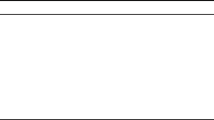Abstract
The recruiting system in foraging ant colonies is a typical example of swarm intelligence. The system is underpinned by the use of volatile pheromones which form a trail connecting from nest to food. We have incorporated this property into the behavior of the swarm of real robots. Because the trail is narrow, avoiding overcrowding on the trail, as well as in the environment, is a critical issue in maintaining efficiency of the swarm behavior. In this paper, we studied how “priority rule,h a behavioral rule under which a robot is given priority over the other robot in collision, affect the group-foraging performance of pheromone-mediated swarm robots. Using real robot experiments, we found that the alteration in the priority rules can have substantial effects on the group-foraging performance. Our results highlight the importance of implementing “fine-tuningh algorithms to improve the performance of complex swarm systems.
Access this chapter
Tax calculation will be finalised at checkout
Purchases are for personal use only
Preview
Unable to display preview. Download preview PDF.
Similar content being viewed by others
References
Fujisawa, R., Imamura, H., Hashimoto, T., Matsuno, F.: Communication using pheromone field for multiple robots. In: Proc. IEEE/RSJ 2008 International Conference on Intelligent Robots and Systems (2008)
Bonabeau, E., Dorigo, M., Theraulaz, G.: Swarm Intelligence. Oxford University Press (1999)
Hölldobler, B., Wilson, E.: The superorganism: the beauty, elegance, and strangeness of insect societies. WW Norton & Company (2009)
Dorigo, M., Stützle, T.: Ant Colony Optimization. Bradford Books (2004)
Sugawara, K., Kazama, T., Watanabe, T.: Foraging behavior of interacting robots with virtual pheromone. In: Proc. IEEE/RSJ Int. Conf. on Intelligent Robots and Systems (IROS 2004), vol. 3, pp. 3074–3079 (2004)
Garnier, S., Tache, F., Combe, M., Grimal, A., Theraulaz, G.: Alice in pheromone land: An experimental setup for the study of ant-like robots. In: Proc. IEEE Swarm Intelligence Symposium (SIS 2007), April 1-5, pp. 37–44 (2007)
Shimoyama, I., Kanzaki, R.: Biological type micromachine. Journal of Society of Biomechanisms 22, 152–157 (1998) (in Japanese)
Purnamadjaja, A.H., Russell, R.A.: Guiding robots behaviors using pheromone communication. Autonomous Robots 23, 113–130 (2007)
Fujisawa, R., Dobata, S., Kubota, D., Imamura, H., Matsuno, F.: Dependency by Concentration of Pheromone Trail for Multiple Robots. In: Dorigo, M., Birattari, M., Blum, C., Clerc, M., Stützle, T., Winfield, A.F.T. (eds.) ANTS 2008. LNCS, vol. 5217, pp. 283–290. Springer, Heidelberg (2008)
Krieger, M., Billeter, J., Keller, L.: Ant-like task allocation and recruitment in cooperative robots. Nature 406, 992–995 (2000)
Chang, D., Shadden, S., Marsden, J., Olfati-Saber, R.: Collision avoidance for multiple agent systems. In: Proceedings of 42nd IEEE Conference on Decision and Control, 2003, vol. 1, pp. 539–543. IEEE (2003)
Burd, M., Archer, D., Aranwela, N., Stradling, D.: Traffic dynamics of the leaf-cutting ant, atta cephalotes. The American Naturalist 159, 283–293 (2002)
Dussutour, A., Fourcassié, V., Helbing, D., Deneubourg, J.: Optimal traffic organization in ants under crowded conditions. Nature 428, 70–73 (2004)
Dussutour, A., Beshers, S., Deneubourg, J., Fourcassié, V.: Priority rules govern the organization of traffic on foraging trails under crowding conditions in the leaf-cutting ant atta colombica. Journal of Experimental Biology 212, 499–505 (2009)
Fujisawa, R., Shimizu, Y., Matsuno, F.: Effectiveness of tuning of pheromone trail lifetime in attraction of robot swarm. In: Proc. on International Symposium on System Integration, SII 2011, D2–2 (2011)
Author information
Authors and Affiliations
Editor information
Editors and Affiliations
Rights and permissions
Copyright information
© 2012 Springer-Verlag Berlin Heidelberg
About this paper
Cite this paper
Fujisawa, R., Dobata, S., Sasaki, Y., Takisawa, R., Matsuno, F. (2012). Collision-Induced “Priority Rule” Governs Efficiency of Pheromone-Communicating Swarm Robots. In: Dorigo, M., et al. Swarm Intelligence. ANTS 2012. Lecture Notes in Computer Science, vol 7461. Springer, Berlin, Heidelberg. https://doi.org/10.1007/978-3-642-32650-9_22
Download citation
DOI: https://doi.org/10.1007/978-3-642-32650-9_22
Publisher Name: Springer, Berlin, Heidelberg
Print ISBN: 978-3-642-32649-3
Online ISBN: 978-3-642-32650-9
eBook Packages: Computer ScienceComputer Science (R0)




